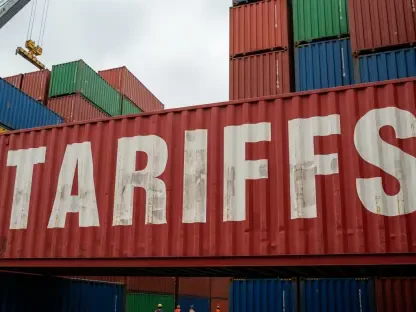The air cargo industry showcased a remarkably robust performance in 2024, continuing to manage strong demand growth effectively, as detailed by Xeneta’s recent market analysis. Notably, global air cargo demand in November demonstrated no signs of deceleration, with volumes marking the 13th consecutive month of double-digit growth. This period saw load factors achieving their highest levels since April 2022. Year-on-year demand in November rose by 10%, significantly driven by an ongoing boom in e-commerce. Air cargo capacity only experienced a slight 2% growth, which resulted in global air cargo spot rates (valid for one month) reaching their peak levels in nearly two years at USD 2.90 per kilogram, observing a sixth consecutive month of double-digit year-on-year growth.
Strong Monthly Performance and Peak Season Expectations
Consistent Growth and High Load Factors
Throughout 2024, the air cargo market demonstrated strong monthly performance, leading to expectations of an exceptional peak season in Q4 from various market sectors. Xeneta’s Chief Airfreight Officer, Niall van de Wouw, acknowledged that although the industry had the ingredients for potentially inflated peak season rates, it successfully avoided this scenario. He emphasized that a ‘peak of all peaks’ should not be a target due to the resultant imbalance between winners and losers. The lesson learned from the disordered peak season of 2023 led to the application of more mature and balanced approaches in 2024, highlighting better resource allocation and improved terms and conditions among all stakeholders.
Van de Wouw pointed out that the peak in 2023 caused significant shortages in capacity and extreme rate fluctuations, adversely impacting shippers. The deliberate avoidance of such peaks in 2024 proved beneficial for maintaining healthy relationships within the supply chain, thus preventing any damage to consumer interests. Consequently, the air freight industry took proactive control of its operations, demonstrating wisdom and restraint. This strategic management approach not only improved the overall functionality of the market but also ensured smoother logistics operations.
Efficient Market Operations and Balanced Viewpoint
November’s Performance and Market Efficiency
While some observers suggested a subdued end to the year for the air cargo market, van de Wouw advocated for a balanced viewpoint. The industry’s performance in November illustrated a market operating efficiently and not spiraling out of control. Volumes were 10% higher than the same peak period in the previous year, and rates experienced a rise as well. The meticulous management ensured that the closing months of 2024, which could have been tumultuous for shippers, remained orderly and well-regulated, thereby earning commendation for the industry’s adept handling. The oversight displayed in November thus provided a clear indication of the air cargo market’s operational maturity and readiness to handle peak demand without disruption.
Persistent Supply-Demand Imbalance
A key finding from the analysis was that the global air cargo spot rates consistently remained above seasonal rates (valid for over one month) since late November 2023. This persistent supply-demand imbalance drove the dynamic load factor in November to reach 63% – its highest in over 30 months. Xeneta’s dynamic load factor measurement took into account the capacity utilization based on the volume and weight of the flown cargo alongside available capacity. This elevated demand bolstered carriers’ negotiating positions. The ability to maintain this delicate balance between supply and demand highlighted the air cargo industry’s savvy management and strategic foresight.
Effective Capacity Management and Regional Trends
Moderate Peak Season Rise
The peak season of 2024 rose less sharply than that of the previous year, owing to carriers’ effective capacity management. During the peak season (beginning in early September and ending the week before December 1), the global air cargo spot rate increased by 12%, a moderate rise compared to a 25% surge during the same period in 2023. This trend was particularly discernible in the Asia market; Northeast Asia saw spot rates to Europe rise by 13% month-on-month to USD 5.09 per kg, while rates to North America grew by 5% to USD 5.20 per kg.
Conversely, Southeast Asia’s spot rates to Europe remained flat at USD 4.15 per kg, and rates to North America declined by 3% to USD 6.05 per kg, driven by eased volumes. Despite this, spot rates had exceeded 2023’s peak season levels since late May 2024. Meanwhile, the Transatlantic market experienced more pronounced freight rate increases as cargo capacity was diverted at the end of the summer travel season. Europe to North America spot rates climbed by 46% from the previous month to USD 2.72 per kg, contrasting with a mere 9% month-on-month growth a year earlier. Similarly, Europe to Latin America rates rose by 23% to USD 4.58 per kg. A noteworthy disruption, like the five-day embargo in Sao Paulo, Brazil, further exacerbated rates due to digital customs delays stemming from a nationwide strike.
Industry Maturation and Future Outlook
Achieving Market Stability
The air cargo industry exhibited outstanding performance in 2024, consistently managing the growth in demand effectively, as highlighted in Xeneta’s recent market analysis. Global air cargo demand in November showed no signs of slowing down, with volumes experiencing the 13th consecutive month of double-digit growth. During this period, load factors achieved their highest levels since April 2022. Year-on-year demand in November increased by 10%, largely fueled by a continuing surge in e-commerce. However, air cargo capacity only saw a modest 2% growth. This limited capacity led to global air cargo spot rates (which are valid for one month) reaching nearly two-year high levels at USD 2.90 per kilogram. Additionally, November marked the sixth consecutive month of double-digit year-on-year growth in spot rates. These developments underscore the robust resilience of the air cargo industry in the face of continuing strong demand and limited capacity growth, resulting in higher spot rates and load factors.









